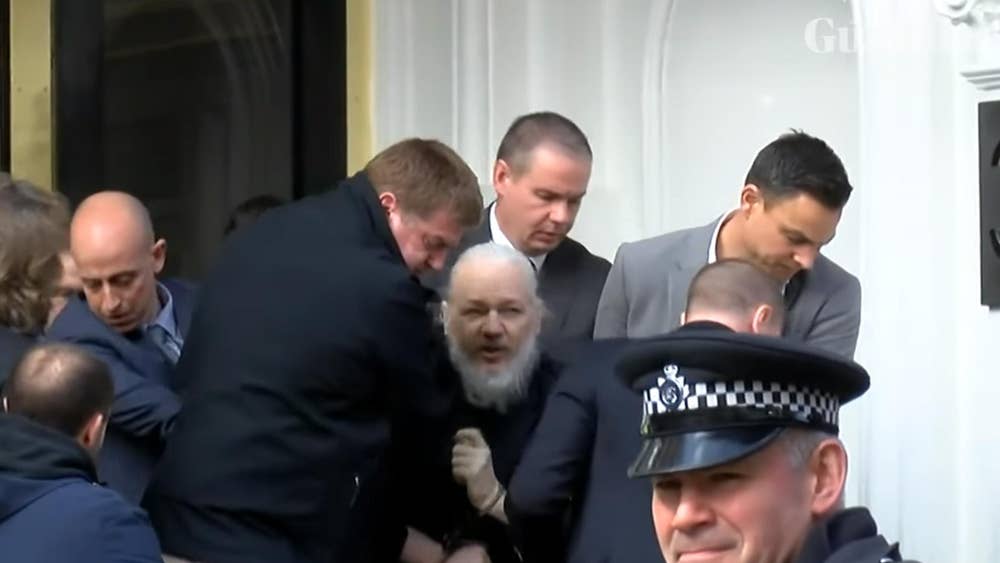
Enough of lies about Julian Assange!
x John Pilger: The bourgeois press is concerned about the "Assange effect": the thugs who took Assange out of the Ecuadorian embassy may one day come for them
Newspapers and other media in the US and Britain have recently declared their passion for freedom of expression, especially for their right to publish freely. It is because they are worried about the "Assange effect."
It is as if the struggle of those who speak the truth, such as Julian Assange and Chelsea Manning, now represents a warning to them: that the thugs who took Assange out of the Ecuadorian embassy in April may one day come for them.
The Guardian echoed a common refrain last week. The extradition of Assange, the newspaper said, “is not a question about how intelligent Assange can be, let alone about how pleasant it can be. It is not about his character, or his opinions. It has to do with freedom of the press and with the public's right to know. ”

Assange out of the Ecuadorian embassy may one day come for them
What The Guardian is trying to do is separate Assange from its fundamental achievements, achievements of which The Guardian has benefited while exposing its own vulnerability, along with its tendency to flatter predatory power and defame those who reveal its double standards.
The poison that has been fueling the persecution of Julian Assange is not as obvious in that editorial as it usually is; there is no fiction in which Assange does not stain the walls of the embassy or behaves horribly with his cat.
Instead, the misleading references to "character", "judgment" and "sympathy" perpetuate an epic stain that is almost a decade old. Nils Melzer, United Nations Rapporteur on Torture, used a more adequate description. “There has been,” he wrote, “a relentless and unrestricted campaign of public harassment.” He explains harassment as “an endless stream of humiliating, degrading and threatening statements in the press.” This “collective scorn” amounts to torture and could lead to at the death of Assange.
Having witnessed much of what Melzer describes, I can attest to the truth of his words. If Julian Assange succumbs to the cruelties accumulated on him, week after week, month after month, year after year, as doctors warn, newspapers like The Guardian would have to share that responsibility.
A few days ago, a guy from the Sydney Morning Herald in London, Nick Miller, wrote a careless and misleading article entitled: "Assange has not been acquitted, he has simply mocked justice." He was referring to Sweden's abandonment of the alleged investigation into Assange.
Miller's report is not atypical because of his omissions and distortions, although he pretends to be a platform for women's rights. There is no original work, there is no real investigation: only slander.
There is nothing about the documented behavior of a group of Swedish fans who kidnapped the “accusations” of inappropriate sexual behavior against Assange and made fun of Swedish law and the much vaunted decency of that society.
He does not mention that, in 2013, the Swedish prosecutor tried to abandon the case and sent an email to the Crown Prosecutor's Service (SFC) in London to tell him that he was no longer going to try to get a European arrest warrant. who received the answer: "Don't you dare!" [My thanks to Stefania Maurizi de La Repubblica.]
Other emails show that the SFC discouraged Swedes from going to London to interview Assange, something that was common practice, thereby blocking the progress that could have freed him in 2011.
There was never accusation. There were never charges. There was never a serious attempt to impute “accusations” to Assange or to question him, behavior that the Swedish Court of Appeals ruled negligent and that the Secretary General of the Swedish Bar Association has since been condemning.
The two women involved later said there was no violation. There is important written evidence that their text messages were intentionally stolen from Assange's lawyers because they clearly undermined the "accusations" (https://lahaine.org/cO1z).
One of the women was so surprised that Assange was arrested, that she accused the police of having pressured her and of changing her statement as a witness. The chief prosecutor, Eva Finne, dismissed any "suspected crime."
The Sydney Morning Herald man omits that an ambitious and committed politician, Claes Borgström, appeared behind the liberal facade of Swedish politics and seized and revived the case.
Borgström recruited a former political collaborator, Marianne Ny, as the new prosecutor. Ny refused to guarantee that Assange would not end up being sent to the US in case he was extradited to Sweden, though, as The Independent reported: “Informal talks have already been held between US and Swedish officials about the possibility of WikiLeaks founder Julian Assange is placed in US custody, according to diplomatic sources. ” This was an open secret in Stockholm. That egalitarian Sweden has a dark and documented past of leaving people in the hands of the CIA was not news.
The silence was broken in 2016 when the United Nations Working Group on Arbitrary Detention, an agency that decides whether governments meet their human rights obligations, ruled that Julian Assange had been illegally detained by Britain and asked the Government British to let him free.

1995-2019: Julian Assange, And The Way He Looked - The ...
Both the Governments of Great Britain and Sweden had participated in the UN investigation and agreed to respect their ruling, which had the weight of international law. But British Foreign Secretary Philip Hammond stood in Parliament and insulted the UN panel.
The Swedish case was a fraud from the moment the police secretly and illegally contacted a sensationalist newspaper in Stockholm and unleashed the hysteria that was going to devour Assange. WikiLeaks' revelations of US war crimes had shamed those servants of power, with their vested interests, who called themselves journalists; and for this, the unsociable Assange was never going to be forgiven.
The ban was open. Assange's media torturers cut and beat each other's lies and insulting abuse. "He is really one of the most massive shits," wrote The Guardian columnist Suzanne Moore. The common trial reached was that he had been charged, which was never true. In my career, in which I have reported from places that recorded extreme agitation, suffering and criminality, I have never seen anything like that.
In the homeland of Assange, Australia, it was where this "harassment" reached its peak. The Australian Government was so anxious to deliver its citizen to the US that in 2013 the Prime Minister, Julia Gillard, wanted to take away her passport and charge her with a crime, until she was told that Assange had not committed any crime and that she had no right to take away his citizenship.
According to the Honest History website, Julia Gillard holds the record of the most flattering speech ever made before the US Congress. Australia, she said to the applause, was the "great companion" of the United States. The great companion colluded with the US in her persecution of an Australian whose crime was journalism, denying her right to adequate protection and assistance
When Assange's lawyer, Gareth Peirce, and I met two Australian consular officials in London, we were surprised that everything they knew about the case "is what we read in the newspapers."
This abandonment by Australia was one of the main reasons for Ecuador to grant him political asylum. As an Australian, I found this situation especially shameful.
When asked recently about Assange, current Australian Prime Minister Scott Morrison said: "He should face the consequences." This type of thugs, devoid of any respect for truth and rights, principles and the law, is the reason why the press mostly controlled by Murdoch in Australia is now worried about their own future, since The Guardian He is worried and The New York Times is worried. All this concern has a name: "Assange's precedent."
They know that what happens to Assange can happen to them. The basic rights and justice that are denied to him can also be denied to them. They have been warned. All of us have been warned.
Every time I see Julian in the gloomy and surreal world of Belmarsh prison, I remember the responsibility of all those who defend him. There are universal principles at play in this case. He usually says: “It's not about me. It's something much broader. ”
But at the heart of this remarkable struggle - because it is, above all, a struggle - is a human being whose character, I repeat, character, has shown the most amazing courage. I greeted him.
(Edited version of a speech that John Pilger offered at the London launch of the book "In Defense of Julian Assange," an anthology published by Or Books, New York.)

